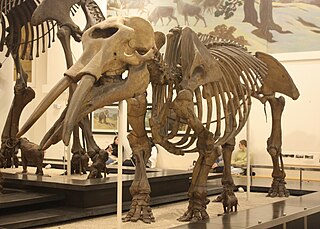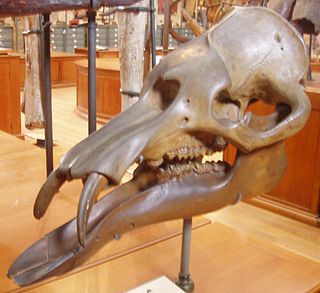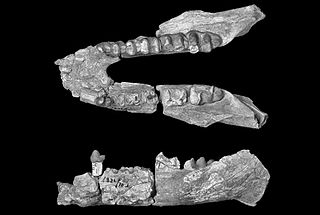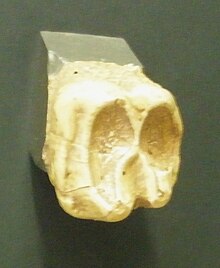
Proboscidea is a taxonomic order of afrotherian mammals containing one living family (Elephantidae) and several extinct families. First described by J. Illiger in 1811, it encompasses the elephants and their close relatives. Three species of elephant are currently recognised: the African bush elephant, the African forest elephant, and the Asian elephant.

Mammutidae is an extinct family of proboscideans belonging to Elephantimorpha. It is best known for the mastodons, which inhabited North America from the Late Miocene until their extinction at beginning of the Holocene, around 11,000 years ago. The earliest fossils of the group are known from the Late Oligocene of Africa, around 24 million years ago, and fossils of the group have also been found across Eurasia. The name "mastodon" derives from Greek, μαστός "nipple" and ὀδούς "tooth", referring to their characteristic teeth.

Gomphotheres are an extinct group of proboscideans related to modern elephants, widespread across Afro-Eurasia and North America during the Miocene and Pliocene epochs and dispersed into South America during the Pleistocene as part of the Great American Interchange. Gomphotheres are a paraphyletic group ancestral to Elephantidae, which contains modern elephants, as well as Stegodontidae.

Deinotheriidae is a family of prehistoric elephant-like proboscideans that lived during the Cenozoic era, first appearing in Africa, then spreading across South Asia (Indo-Pakistan) and Europe. During that time, they changed very little, apart from growing much larger in size; by the late Miocene, they had become the largest land animals of their time. Their most distinctive features were their lack of upper tusks and downward-curving tusks on the lower jaw.

Paraceratherium is an extinct genus of hornless rhinocerotoids belonging to the family Paraceratheriidae. It is one of the largest terrestrial mammals that has ever existed and lived from the early to late Oligocene epoch. The first fossils were discovered in what is now Pakistan, and remains have been found across Eurasia between China and the Balkans. Paraceratherium means "near the hornless beast", in reference to Aceratherium, the genus in which the type species P. bugtiense was originally placed.

Paraceratheriidae is an extinct family of long-limbed, hornless rhinocerotoids, native to Asia and Eastern Europe that originated in the Eocene epoch and lived until the end of the Oligocene. They represent some of the largest terrestrial mammals to have ever lived.

Pyrotherium is an extinct genus of South American ungulate, of the order Pyrotheria, that lived in what is now Argentina and Bolivia, during the Late Oligocene. It was named Pyrotherium because the first specimens were excavated from an ancient volcanic ash deposit. Fossils of the genus have been found in the Deseado and Sarmiento Formations of Argentina and the Salla Formation of Bolivia.
Numidotheriidae is an extinct family of primitive proboscideans that lived from the late Paleocene to the early Oligocene periods of North Africa.

Barytherium is a genus of an extinct family (Barytheriidae) of primitive proboscideans that lived during the late Eocene and early Oligocene in North Africa. The type species is Barytherium grave, found at the beginning of the 20th century in Fayum, Egypt. Since then, more complete specimens have been found at Dor el Talha, Libya. More fossils were also discovered in 2011 in the Aidum area in Dhofar by Oman's Ministry of Heritage and Culture, which was named Barytherium omansi.
Eritreum melakeghebrekristosi is an extinct species of proboscidean mammal, which lived in Northeast Africa during the late Oligocene some 27 million years ago, and is considered to be the missing link between modern elephants and their ancestors. The fossils of this species are the oldest known fossils featuring the horizontal tooth displacement seen in modern elephants. The species is estimated to have weighed 484 kg (1,067 lb) and stood about 1.3 m (4.3 ft) at the shoulder, much smaller than modern species.

Palaeomastodon is an extinct genus within the elephant order Proboscidea. Its fossils have been extracted from Oligocene strata conventionally dated to 33.9-23.03 million years old. Usually considered an ancestor or near-ancestor of elephants or mastodons as a member of Elephantiformes it lived in marshes and fluvial-deltaic environments of what is now Egypt, Ethiopia, Libya, and Saudi Arabia.

Paraentelodon is an extinct entelodont from the Late Oligocene and Oligocene-Miocene boundary of Asia. The fossils of the type species P. intermedium were found in Georgia, Kazakhstan and China. An indeterminate species represents in Bugti Hills which is the late Oligocene of Pakistan.

Stegodontidae is an extinct family of proboscideans from Africa and Asia from the Early Miocene to the Late Pleistocene. It contains two genera, the earlier Stegolophodon, known from the Miocene of Asia and the later Stegodon, from the Late Miocene to Late Pleistocene of Africa and Asia which is thought to have evolved from the former. The group is noted for their plate-like lophs on their teeth, which are similar to elephants and different from those of other extinct proboscideans like gomphotheres and mammutids, with both groups having a proal jaw movement utilizing forward strokes of the lower jaw. These similarities with modern elephants were probably convergently evolved. Like elephantids, stegodontids are thought to have evolved from gomphothere ancestors.

Saadanius is a genus of fossil primates dating to the Oligocene that is closely related to the common ancestor of the Old World monkeys and apes, collectively known as catarrhines. It is represented by a single species, Saadanius hijazensis, which is known only from a single partial skull tentatively dated between 29 and 28 million years ago. It was discovered in 2009 in western Saudi Arabia near Mecca and was first described in 2010 after comparison with both living and fossil catarrhines.

Elephantiformes is a suborder within the order Proboscidea. Members of this group are primitively characterised by the possession of upper tusks, an elongated mandibular symphysis and lower tusks, and the retraction of the facial region of the skull indicative of the development of a trunk. The earliest known member of the group, Dagbatitherium is known from the Eocene (Lutetian) of Togo, which is only known from isolated teeth, while other primitive elephantiforms like Phiomia and Palaeomastodon are known from the Early Oligocene onwards. Phiomia and Palaeomastodon are often collectively referred to as "palaeomastodonts" and assigned to the family Palaeomastodontidae. Most diversity of the group is placed in the subclade Elephantimorpha, which includes mastodons, as well as modern elephants and gomphotheres (Elephantida). It is disputed as to whether Phiomia is closely related to both Mammutidae and Elephantida with Palaeomastodon being more basal, or if Palaeomastodon is closely related to Mammutidae and Phiomia more closely related to Elephantida.
Propliopithecoidea is a superfamily of catarrhine primates that inhabited Africa and the Arabian Peninsula during the Early Oligocene about 32 to 29 million years ago. Fossils have been found in Egypt, Oman and Angola. They are one of the earliest known families of catarrhines. They have a number of features in common with extant catarrhines, but also features that are primitive and not found in later catarrhine families.

Arcanotherium is an extinct genus of early proboscidean belonging to the family Numidotheriidae that lived in North Africa during the late Eocene/early Oligocene interval.
Omanitherium is a genus of an extinct genus of barytheriid proboscidean that lived during the early Oligocene in Oman. It belongs to the family Barytheriidae, which represented the first large size proboscideans to appear in the fossil record and were characterized by a strong sexual dimorphism.
Baguatherium is an extinct genus of herbivorous mammal, belonging to the order Pyrotheria. It lived during the Early Oligocene, and its fossilized remains were discovered in Peru.













